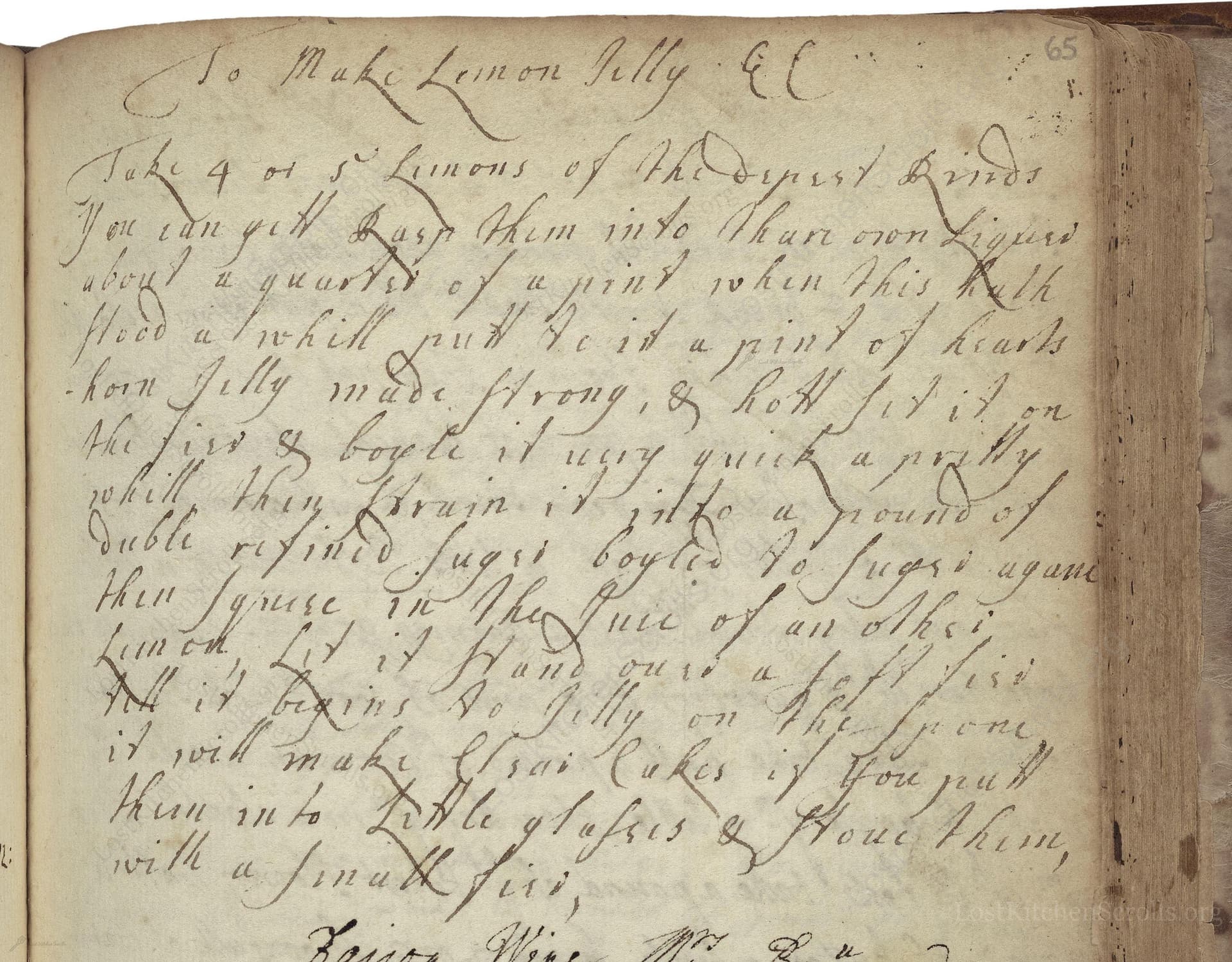To Make Lemon Jelly &C
From the treasured pages of Receipt book of Penelope Jephson
Written by Penelope Patrick

To Make Lemon Jelly &C
"Take 4 or 5 Lemons of the depeest Rinds you can gett Rasp them into about a quart or a pint when this Hath stood a whill put to it a pint of hearts horn Jelly made strong, & sett it on the fire & boyle it very quick a pretty whill then strain it til a pound of duble refined suggr boyle it againe then squise in the Juice of an other Lemon let it stand over a soft fire till it begins to Jelly on the spone it will make Clear Cakes if you pull them into litle glasses & stove them, with a small fire,"
Note on the Original Text
The recipe employs the direct, narrative style typical of 17th-century manuscripts: instructions are embedded in long sentences without precise measurements or times. Spellings such as 'boyle' for 'boil', 'suggr' for 'sugar', and 'whill' for 'while' reflect historical orthography, and ingredient amounts like 'a quart or a pint' or 'a pound of duble refined suggr' are approximate, requiring the cook’s intuition. Hartshorn jelly—now unusual—was once a standard gelling agent, here replaced with modern gelatin for practicality. The technique described would result in a translucent, citrusy jelly, forming 'clear cakes' meant for elegant culinary displays.

Title
Receipt book of Penelope Jephson (1673)
You can also click the book image above to peruse the original tome
Writer
Penelope Patrick
Era
1673
Publisher
Unknown
Background
Step back into the sumptuous kitchens of the late 17th century with Penelope Patrick’s culinary collection—a feast of historic recipes, secret tips, and the irresistible flavors of Restoration England all bound together in a handwritten treasure.
Kindly made available by
Folger Shakespeare Library
This lemon jelly recipe hails from the handwritten collection of Penelope Patrick, dating to the early 1670s in England. At the time, sugar was a luxury, and gelatinous confections like fruit jellies or 'clear cakes' were favored at elite tables. Hartshorn jelly, originally made by boiling deer antlers for their gelling properties, was a standard thickener before powdered gelatin existed. Recipes like this would be served at grand banquets or as sweetmeats to impress guests, reflecting status and culinary sophistication in Restoration-era kitchens. The recipe itself appears in a domestic manuscript, highlighting the role of women as keepers and transmitters of culinary knowledge.

Essential tools would have included a fine grater or rasp for zesting the lemon, large copper pots for boiling, muslin or fine cloths for straining, and glass or earthenware molds for setting the jelly. A gentle heat was provided by a cool oven or warmed hearth area to help the jelly set and dry into translucent cakes. Wooden spoons and ceramic bowls rounded out the batterie de cuisine. These tools allowed for precise management of sugar work and gel confections, despite the lack of modern thermometers or refrigeration.
Prep Time
15 mins
Cook Time
20 mins
Servings
8
We've done our best to adapt this historical recipe for modern kitchens, but some details may still need refinement. We warmly welcome feedback from fellow cooks and culinary historians — your insights support the entire community!
Ingredients
- 4–5 lemons, preferably with thick, deeply colored rinds
- 1–2 cups (8–16 fl oz) water
- 2 cups (16 fl oz) strong gelatin (substitute for historical hartshorn jelly; use approximately 0.6 oz [18 g] powdered gelatin for this amount of liquid)
- 2 cups (1 lb) double refined sugar (superfine or caster sugar)
- Juice of 1 additional lemon
Instructions
- Begin by selecting 4 to 5 lemons with thick, deeply colored rinds.
- Gently grate or zest the rind into approximately 1 to 2 cups of water (about 8 to 16 fl oz), allowing the mixture to infuse for a short while.
- Meanwhile, prepare 2 cups (about 16 fl oz) of strong gelatin using powdered gelatin as a substitute for 'hartshorn jelly' (the historical version made from deer antlers).
- Combine the lemon zest infusion with the gelatin and bring to a rapid boil for a few minutes.
- Strain the mixture, then add 1 pound (2 cups) of superfine (caster) sugar, letting it boil once more.
- Squeeze the juice of one additional lemon and stir it in.
- Let the mixture simmer gently until it begins to set on the spoon (test for gelling).
- Pour the jelly into small glasses or molds, and allow them to set in a mildly warm oven or dehydrator, replicating the gentle drying process, to form clear jelly cakes.
Estimated Calories
220 per serving
Cooking Estimates
You will need about 15 minutes to zest the lemons, prepare the gelatin, and combine the ingredients. Cooking and boiling the mixture takes about 20 minutes. Setting the jelly will take another 2 hours, but you don’t need to be active during this time. Each serving has about 220 calories. This recipe makes 8 servings.
As noted above, we have made our best effort to translate and adapt this historical recipe for modern kitchens, taking into account ingredients nowadays, cooking techniques, measurements, and so on. However, historical recipes often contain assumptions that require interpretation.
We'd love for anyone to help improve these adaptations. Community contributions are highly welcome. If you have suggestions, corrections, or cooking tips based on your experience with this recipe, please share them below.
Join the Discussion
Rate This Recipe
Dietary Preference

Den Bockfisch In Einer Fleisch Suppen Zu Kochen
This recipe hails from a German manuscript cookbook compiled in 1696, a time whe...

Die Grieß Nudlen Zumachen
This recipe comes from a rather mysterious manuscript cookbook, penned anonymous...

Ein Boudain
This recipe comes from an anonymous German-language manuscript cookbook from 169...

Ein Gesaltzen Citroni
This recipe, dating from 1696, comes from an extensive anonymous German cookbook...
Browse our complete collection of time-honored recipes



